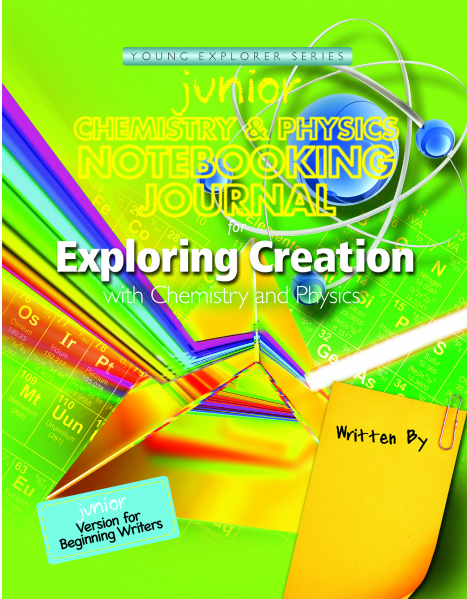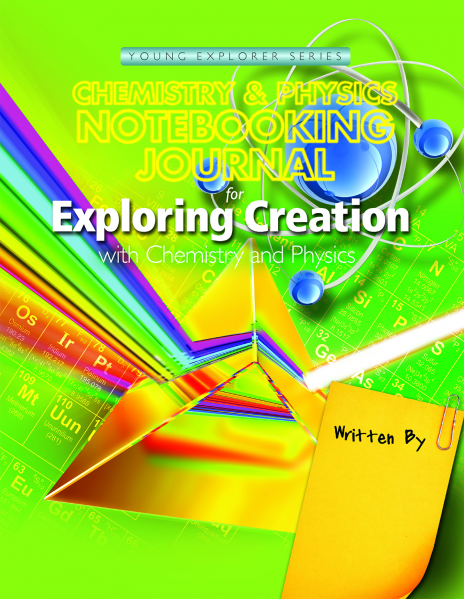
About The Company:
Apologia Educational Ministries is probably most known for their homeschool science curriculum. One of their popular ones is the Young Explorers series; Exploring Creation with….. elementary science curriculum.
We were blessed to be able to try out their newest addition to this line up written by Jeannie Fulbright; Exploring Creation with Chemistry and Physics.
About The Product:
Exploring Creation with Chemistry and Physics is priced at $39.00. This is recommended for kids in grades Kindergarten through 6th grade. Watch for tons of pictures of many of the projects we did throughout our short time using it. Also stay tuned for future blog posts to see what other projects we are up to using this homeschool science curriculum. 
In this book you will learn all about chemistry and physics, including, atoms, molecules, elements, simple chemicals, laws of motion, electricity, magnetism, simple machines and more.
Learning about Density
This book is divided into 14 lessons. Each lesson takes Katey and I approximately 3 weeks to get through using the Jr. Notebooking Journal (see below). Each lesson takes Emily about 2 weeks to get through using the Notebooking Journal (see below).
Katey calls it potion science.
Learning about density by making homemade lava lamps
The 14 lessons are:
- Chemistry and Physics Matter
- Moving Matter
- Building Blocks of Creation
- Compound Chemistry
- Multitude of Mixtures
- Mechanics in Motion
- Dynamics in Motion
- Work in the World
- Sound of Energy
- Light of the World
- Thermal Energy
- Electrifying our World
- Mysterious Magnetism
- Simple Machines
Each lesson has plenty of smaller hands on activities/ experiments that are simple and ends with a bigger project.
There are two separate notebooking journals based on age and/or ability.

The Jr. Notebooking Journal is priced at $24.00 and is for younger elementary students and those with limited writing skills.
Learning about buoyancy
The Jr. Journal has some coloring pages and drawing projects as well as simple crossword puzzles and foldable books to create.
The Notebooking Journal is also priced at $24.00 and is for upper elementary students and those comfortable writing.
The Notebooking Journal has plenty of space for journaling and copywork as well as places to draw and document. There are also foldable books and crossword puzzles.
A day/week in our life:
I actually chose to use this separately with my two girls, one age 13 and one age 8.
Making the Periodic Table of Elements out of sugar cookies
I had my 13 year old work on her own and let her choose with of the smaller experiments she wanted to do. She was required to do the bigger projects at the end of each lesson. She is much more of a visual learning. Seeing the pictures in the book and reading the text works for her. She does often join us when I am doing the smaller experiments with her younger sister. She uses the upper version of the notebooking journal following the schedule on the inside but working on it 4 days a week instead of the suggested two. She gets through a lesson in approximately 2 weeks which is about double the speed in the suggested schedule. She does almost all of the notebooking pages in her notebook.
Learning about the properties of matter. Is this a solid or a liquid?
Katey, my 8 year old, works with me. I read to her and we discuss what we read and she works a little bit on a notebooking project each day. She does not do all of the notebook. I just let her pick a page to work on for about 10 minutes a day and then when she finishes it she chooses another page. We do almost all of the small in lesson experiments. They are usually simple hands on things that can be done quickly. We do science twice a week together. We get through a lesson in about 3 to 4 weeks. Going slow and taking our time. It is no way necessary to do all the experiments as that is what takes up most of our time. Katey is just a very hands on learner so this is great for her.
Learning about different freezing points with a competitive graph.
Our thoughts and feelings:
We have been extremely happy with the science curriculum. It is full of quick experiments and fits many of the learning styles. I love that it can be done mostly independently or as a parent/ child together curriculum.
We are not the only ones to use this, to see what others think, click the banner:

To see a wide variety of reviews check out our crew blog.
















No comments:
Post a Comment